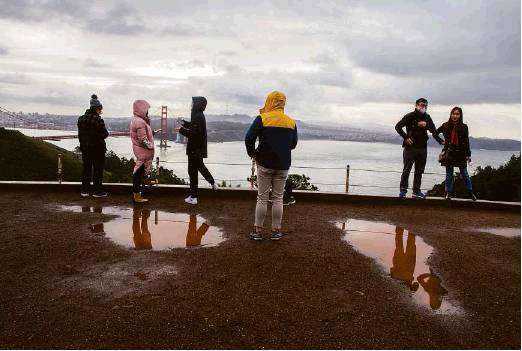Big storms lessening drought’s severity
State hasn’t fully recovered despite ample precipitation
By Joaquin Palomino
A barrage of winter storms has pulled much of California, including parts of the Bay Area, out of the most severe drought conditions, providing hope that the state and region will get a respite from a historically dry period.
New maps released last week by the U.S. Drought Monitor show nearly all of California emerging from “exceptional drought” — signaling widespread water shortages, an acute risk of wildfires, and severe risks to native plants and animals — though some level of drought conditions remains in nearly all of the state.
In a dramatic turnaround, California’s current “water year” already has totaled more precipitation than in all of last year, the National Weather Service said over the weekend. The downpours and mountain storms of recent weeks have helped boost the state’s precipitation volume to 33.9 trillion gallons thus far, compared with last year’s 33.6 trillion gallons, the service said. The water year refers to 12 months of precipitation starting from Oct. 1 of each year.
While the wet weather was welcomed, parts the Bay Area were among areas remaining in extreme drought.
Just a little more than a week ago — before winter storms dropped feet of snow in the Sierra and rain across lower-lying parts of the state — nearly a quarter of California was experiencing exceptional drought, including much of the San Joaquin Valley and parts of the East Bay.
The snowpack in California’s mountains is now at 160% of average for this time of the year, and additional rain and snow is forecast in the coming weeks.
“A good portion of the state has already exceeded the amount of precipitation, generally speaking, compared to the previous 12 months as a whole,” meteorologist Scott Rowe at the National Weather Service in Sacramento said Sunday. But, he added, “if we were to suddenly go dry right now, we still would not be where we should be for any given water year.”
An average water year for California would see about 70 trillion gallons, Rowe said.
Significant rain in January and February will be needed to offset the past two winters, which were state’s fifth- and second-driest on record, according to the state Department of Water Resources.
“California continues to experience evidence of climate change with bigger swings between wet and dry years and even extreme variability within a season,” said Sean de Guzman, manager of the Department of Water Resources’ snow surveys and Water Supply Forecasting Unit.
“A wet start to the year doesn’t mean this year will end up above average once it’s all said and done.”
Last week, Shasta Lake, the state’s biggest reservoir, contained just half of its usual water amount for this time of year. Lake Oroville, the second-largest, stood at 73% of where it generally is at this point.
The reservoirs are expected to continuing filling up with runoff from recent storms. Precipitation in the region was at 169% of average as of Thursday, among its highest-ever at this point in the water year, as measured by the Northern Sierra Eight-Station Precipitation Index.
San Francisco Chronicle staff writers Kurtis Alexander and Jessica Flores contributed to this report.
Joaquin Palomino is a San Francisco Chronicle staff writer. Email: jpalomino@sfchronicle.com Twitter: @JoaquinPalomino
